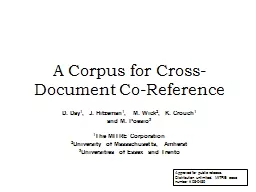

D Day 1 J Hitzeman 1 M Wick 2 K Crouch 1 and M Poesio 3 1 The MITRE Corporation 2 University of Massachusetts Amherst 3 Universities of Essex and Trento Approved for public release ID: 788572
Download The PPT/PDF document "A Corpus for Cross-Document Co-Reference" is the property of its rightful owner. Permission is granted to download and print the materials on this web site for personal, non-commercial use only, and to display it on your personal computer provided you do not modify the materials and that you retain all copyright notices contained in the materials. By downloading content from our website, you accept the terms of this agreement.
Slide1
A Corpus for Cross-Document Co-Reference
D. Day1, J. Hitzeman1, M. Wick2, K. Crouch1 and M. Poesio31The MITRE Corporation2University of Massachusetts, Amherst3Universities of Essex and Trento
Approved for public release.
Distribution
unlimited. MITRE case number # 08-0489
Slide2Within-doc Coreference
The LDC has developed a corpus for within-doc coreference, i.e., when a phrase in a document refers back to a previously mentioned entity“Smith succeeded Jones as CEO of the company. He started his career at IBM….”
Slide3In order to determine a chain of events, the movements of a person, changes in ownership of a company, etc., we need a corpus that identifies co-referring mentions of entities appearing in different documents
“Smith succeeded Jones as CEO of the company. He started his career at IBM….”“Smith is currently the vice-president of IBM. He was hired in 1972 in order to improve profits.”
Cross-doc Coreference
Slide4The Johns Hopkins Workshop
Johns Hopkins hosted a summer workshopTo investigate the use of lexical and encyclopedic resources to improve coreference resolutionTo build a cross-doc corpusTo build systems to perform cross-doc coreferenceOne question was how far the techniques we use on within-doc coreference would work with cross-doc coreferenceOur team was in charge of building the corpusWe intend to release this corpus for unlimited use and distribution
Slide5The Technique
We began with the within-doc corpus developed by the LDC for the Automated Content Extraction competition (ACE)We built the Callisto/EDNA annotation toolA specialized annotation task plug-in for the Callisto annotation tool (http://callisto.mitre.org)A Callisto client plug-in that uses a web server (Tomcat) and search/indexing web services plug-ins that support multiple simultaneous annotators
Slide6Slide7The Search Query and
Search Results Panes
Slide8Search Results Details Pane
Slide9The Annotation Process
Criteria for considering cross-referencing entitiesIt has at least one mention of type NAME within a documentIt is of type PER, ORG, GPE or LOCTo expedite the process, we applied an initial automated cross-doc linking prior to manual annotationE.g., all mentions of “Tony Blair” were coreferencedWhen a NAME is common, this pre-linking saved the annotator many mouse clicks
Slide10The Pre-Linking Process
The pre-linked entities had to have at least one identical NAME mention and to be of the same TYPE and SUBTYPEWe were concerned that the automatic pre-linking would produce errors but it produced very fewThe errors were largely due to errors in the within-doc data, e.g., within-doc coreferencing of“anonymous speaker” with other anonymous speakers“Scott Peterson” and “Laci Peterson”
Slide11The ACE2005 English EDT Corpus
1.5 million characters257,000 words18,000 distinct document-level entities (prior to cross-doc linking)PER 9.7KORG 3KGeo-Political entity (GPE) 3KFAC 1KLOC 897Weapon 579Vehicle 57155,000 entity mentionsPronoun 20KName 18KNominal 17K
Slide12Resulting Entities
7,129 entities satisfied the constraints required for cross-doc annotationAutomatic and manual annotation resulted in 3,660 entitiesOf these, 2,390 entities were mentioned in only one document
Slide13Comparison to Previous Work
John Smith corpus (Bagga, et al, 1998)Baldwin and Bagga created a cross-doc corpus and evaluated it for the common name “John Smith”Benefits of our workBy using an existing within-doc corpus, we have high-quality co-reference information for both within-doc and cross-docThe size of this corpus is significantly larger than previous data sets
Slide14Data Format
The output is similar to the ACE APF format<entity CLASS="SPC" ID="AFP_ENG_20030323.0020-E62" SUBTYPE="Individual" TYPE="PER"> <entity_mention ID="AFP_ENG_20030323.0020-E62-86" LDCTYPE="NAMPRE" TYPE="NAM"> <extent><charseq END="3161" START="3152">
John Wayne
</charseq>
...
<external_link EID="1772"
RESOURCE="elerfed-ed-v1"/>
</entity>
Slide15Observations
One side effect of performing cross-doc coreference is that it showed errors in the within-doc annotationE.g., “Scott Peterson” and “Laci Peterson” are coreferenced because there is a misannotated reference to “Peterson”It allowed us to cross-reference names with nicknames which will not be found in a gazetteerE.g., “Bama” with “Alabama”“Q”, “Qland”, “Queensland”This co-referencing allows nicknames to be mapped using a gazetteer
Slide16Scoring
To test the ambiguity of the dataset, we implemented a discriminatively trained clustering algorithm similar to Culotta et all (2007)We measured cross-doc coreference performance on a reserve test set of gold standard documentsF=.96 (Bcubed)F=.91 (Pairwise)F=.89 (MUC)